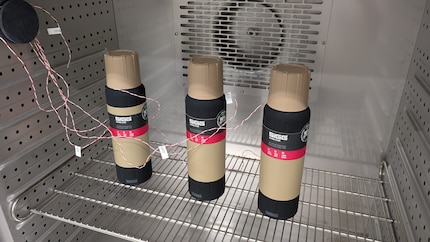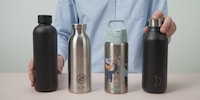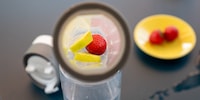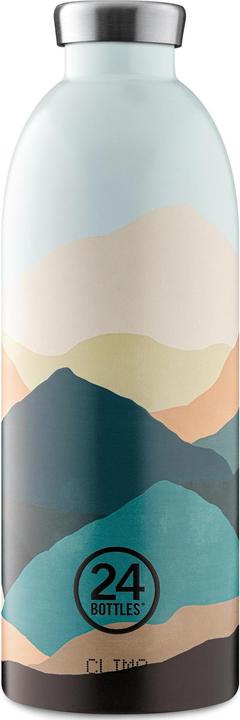

How long do thermos flasks keep liquids hot? The specs aren’t always accurate
Thermos bottles are popular. When buying one, I’m sure you’d look at how long it keeps a cold drink cool and tea scalding hot. However, manufacturers’ specifications should be taken with a grain of salt.
Around 5,000 thermos flasks are just waiting to be bought on Galaxus. So, how can you find the right bottle for you?
A good thermos should be good at one thing above all: insulating. In other words, any hot or cold liquid you’ve poured in should stay at its starting temperature for as long as possible. Almost all manufacturers rely on the principle of vacuum insulation. Thermos flasks have two walls, with a vacuum between the inner and outer layers. This prevents heat conduction since, for example, cold ambient air doesn’t directly affect the inner wall of the bottle touching your tea or coffee. Even better, a smooth polished or mirrored inner wall helps reflect heat radiation too.
The European standard (EN), number 12546-1, designates and approves proper thermos flasks. It regulates how insulated containers for household use should be designed. It also specifically dictates how heat retention and heat loss can be checked.
The insulating vessel has to be preheated with hot water (≥95 °C) for (5 ± 1) minutes up to the nominal filling volume, then emptied and immediately refilled with boiling water (≥95 °C) up to the nominal filling volume. The lid is then put on. After this, the insulating vessel is left at room temperature (20 ± 2) °C for 6 h ± 5 min. Finally, the water temperature is measured.
The final temperature then has to reach a value again defined in the EN. This exact figure changes depending on the volume of the flask. For example, the previously boiling water in a 500-millilitre bottle has to be at 70 degrees minimum after six hours. For a one-litre bottle, it’s 78 degrees. This follows physics, by the way, since more water retains heat energy better and will cool down slower as a result. So, if you like hot tea, drink it quicker – or carry more of it with you, at least.
However, manufacturers rarely provide information on how hot the liquid in their bottles ended up after the EN measurement. That’d be pretty neat really, since then you could make a fair comparison.
Instead, brands provide you with information on how many hours their bottles keep a drink hot or warm. And that’s a problem. Who actually defines what’s still hot or just warm? Yep, you guessed it: the brand itself.
Starting with 24 Bottles, the brand made things very easy for itself. For every bottle in their Clima range, it simply says:
Clima Bottle is our thermal bottle able to keep your drink hot for 12 hours and cold for 24 hours.
All identical, whether the bottle holds half a litre, a litre or one and a half litres. The 12/24 designation serves to simplify matters and is even printed on the bottom of every bottle. Digging deeper, I asked their customer service in northern Italy how 24 Bottles defines hotness. I haven’t heard back yet, even several days after inquiring. Still, putting out a simple catch-all is understandable. After all, a manufacturer can’t know whether you’re lugging your bottle across the Sahara or whether you’re pondering a cup of tea for your Matterhorn ascent.
Competitor Chilly’s, based in London, is more forthcoming than 24 Bottles. One friendly employee ensured that my drink would stay at a warm and enjoyable temperature for up to 12 hours in a Chilly’s bottle. However, she also explained that the exact temperature can vary. For example, if a bottle isn’t full all the way, its contents cool down quicker. Frequently opening the thermos also isn’t conducive to long-term heat retention. Simple and factual, but pretty vague too.
Swiss transparency and accuracy
But there’s also Swiss brand Sigg. It’s been under Chinese ownership since 2016, but I still get the information I need from them. Stefan Marusic is a Product Development Engineer at Sigg. According to him, they measure the heat retention capacity of thermos flasks according to the method defined in EN 12546-1.
Only, they don’t just stop after six hours, instead measuring across different lengths of time. If the temperature of a liquid falls below 60 degrees, it stops being hot according to Sigg, explains Stefan. He also adds: «But that’s not standard. If a competitor wants to test down to 45 degrees because they define that as hot, they’ll get a better result – on paper.»

Source: SIGG
At Sigg, this self-imposed hard limit of 60 degrees means that some bottles will look worse than the competition. A thermos flask for children with a capacity of 0.5 litres, for example, will «only» keep liquids «hot» for five hours, whereas the equal-size Meridian beats the competition by an hour with thirteen. Finally, the 1.1-litre Gemstone IBT, made for outdoor adventures, can even keep tea hot for 18 hours.
The Wild West of keeping drinks cool
Alright, now you know that a thermos flask has to pass at least one standardised test to be considered as such. However, when it comes to how long a bottle chills a drink, brands can do whatever they want. There’s neither a standard nor a definition. Some mention the term «iced», others «cold», without specifying any temperature. It seems like everyone just agreed that 24 hours sounds cool and is more or less close enough most of the time.
Again, Sigg is precise here. They add water at exactly two degrees Celsius. If it gets warmer than 15 degrees, they stop measuring. Stefan Marusic emphasises that the aim of all their tests is to achieve a standardised and transparent procedure. Their results can then be backed up without a shadow of doubt if customers double-check.
Journalist since 1997. Stopovers in Franconia (or the Franken region), Lake Constance, Obwalden, Nidwalden and Zurich. Father since 2014. Expert in editorial organisation and motivation. Focus on sustainability, home office tools, beautiful things for the home, creative toys and sports equipment.
Interesting facts about products, behind-the-scenes looks at manufacturers and deep-dives on interesting people.
Show allThese articles might also interest you

Product test
Hot in autumn: why I like the thermos flask from 24 Bottles
by Martin Jungfer

Guide
Good and cheap? Or just cheap? How Galaxus’s thermos flask fares against its competition
by Martin Jungfer

Guide
Like water, only better: how to give kids a taste for it with these 5 products
by Michael Restin




